| £ s d |
 |
| Pre-decimal money - pounds, shillings
and pence. |
 |
| The old currency now seems rather odd with its
12 pence to a shilling and 20 shillings to a pound
but there was a structure to the system. There were
three units of currency, the pound, the shilling
and the penny. The largest unit was the pound (£1).
There were multiples of this, such as 5 pounds.
Higher values were rare before the 1960s. |
 |
| The pound was divided in half (ten shillings).
Half of this was a crown, which was only issued
to mark special occasions. The half crown, however,
was in general circulation. So we had £1,
halved = 10/- or 10s (ten shillings), halved again
= 5/- or 5s (crown), halved once more = 2/6d or
2s 6d (half crown). The middle unit was the shilling.
This too was halved (6d), and halved again (3d).
The smallest unit was the penny (1d) which was halved
(½d or halfpenny) and had until 1960 been
halved again to a quarter of a penny (¼d
called a farthing). |
 |
| The odd one out was the 2 shilling coin. This
had been introduced in the nineteenth century as
the florin, a name that stayed in common use, and
was to have been the basic unit for a decimal currency
to replace the pound. In the event decimalization
did not occur until 1971 by which time inflation
had reduced the florin's value and it became the
10 pence piece (10p). |
 |
| Prices were sometimes shown in guineas, a guinea
being one pound and one shilling. 20 guineas looked
less than the 21 pounds it really was but there
was no coin or note. Sums over a pound might be
expressed in shillings, for instance 50/- (fifty
shillings) for £2/10/-. In the 1950s, when
most tailors used guineas to imply quality, one
chain branded itself as The Fifty Shilling Tailor
in order to show its affordability. |
 |
| Causing confusion among foreign tourists, counting
in £sd was second nature to those of us who
grew up with it. No calculators in those days, we
did the sums in our heads! |
 |
| |
  |
equals |
 |
|
|
| Two farthings |
|
A
halfpenny |
Pronounced |
|
| ¼d + ¼d |
|
½d |
a haypny |
|
| |
|
|
|
|
  |
equals |
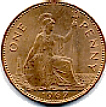 |
|
|
| Two halfpennies |
|
One
penny |
A penny |
|
| ½d + ½d |
|
1d |
two = tuppence |
|
| |
|
|
|
|
   |
equals |
 |
|
|
| Three pennies |
|
Threepence |
Pronounced thruppence |
|
| 1d + 1d + 1d |
|
3d |
A thruppenny
bit |
|
| |
|
|
|
|
  |
equals |
 |
|
|
| Two threepenny bits |
|
Sixpence
|
A sixpence |
|
| 3d + 3d |
|
6d |
Slang: a tanner |
|
| |
|
|
|
|
  |
equals |
 |
|
|
| Two sixpences |
|
A
shilling |
Slang: more than
one as |
|
| 6d + 6d |
|
1s
or 1/- |
bob, eg five
bob |
|
| |
|
|
|
|
  |
equals |
 |
|
|
| Two shillings |
|
Two
shillings |
Slang: two bob |
|
| 1s + 1s or 1/- + 1/- |
|
2s
or 2/- |
or a florin |
|
| |
|
|
|
|
  |
equals |
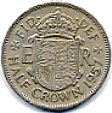 |
|
|
| Two shillings and sixpence |
|
Half
a crown |
also called a
half crown |
|
| 2s + 6d or 2/- + 6d |
|
2s
6d or 2/6 |
or two and six |
|
| |
|
|
|
|
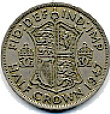    |
equals |
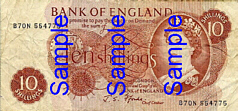 |
|
| Four half crowns |
|
Ten
shillings |
(not to same
scale) |
|
| 2s 6d + 2s 6d + 2s 6d + 2s 6d
or 2/6 + 2/6 + 2/6 + 2/6 |
|
10s
or 10/- |
Slang: ten bob |
|
| |
|
|
|
|
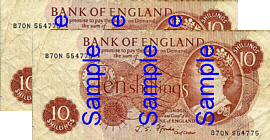 |
equals |
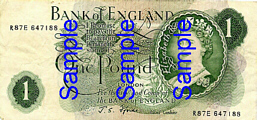 |
|
| Two ten shilling notes |
|
One
pound |
(not to same
scale) |
|
| 10s + 10s or 10/- +10/- |
|
£1 |
|
|
| |
|
|
|
|
|
 |
| Several different designs of each coin could be
in circulation at the same time. It was common to
see coins from throughout the twentieth century
with their different monarchs on the heads side. |
 |
| Notes also changed but did not last as long so
only one design of each would generally be in use. |
 |
| There were a lot of different ways to express
money, both verbally and in writing. Written amounts
in pence were always followed by the letter d, such
as 1d, 3d, 6d, 10d. Amounts in shillings could be
written as 1s or 1/-, 14s or 14/-. Combinations
of shillings and pence were written as 1/3d or 1s
3d (one and threepence), 15/6d or 15s 6d (fifteen
and six) for example. Amounts including pounds could
appear as £1/19/11d or £1 19s 11d (one
pound, nineteen and eleven). Note the use of a dash
instead of a zero, as in 18/- for eighteen shiilings
(and no pence). |
 |
| When talking, people would join the number of
pence and the word pence together. For example,
tuppence (two pence), threepence (pronounced thruppence),
fourpence etc.. When shillings and pence were used
together, the word shilling was generally dropped.
So too could the word pence. For example seventeen-and-sixpence
or seventeen-and-six but seldom seventeen-shillings-and-sixpence.
Halfpenny was pronounced haypny. |
 |
| In addition, there were words to describe certain
amounts. A sixpenny piece was often called a tanner,
a two shilling piece two bob and a ten shilling
note ten bob. A shilling was not generally called
a bob but scouts and cubs held "bob-a-job weeks"
where they did odd jobs for small donations. Some
things seemed to fit a particular value, such as
six pennyworth of chips, a shilling for the meter
- and spending a penny cost exactly that. |
 |
 |
 |
| Coins and notes (19th and 20th centuries) |
 |
| Farthing |
|
A quarter of a penny. Withdrawn 1960 as
by then it had little value. |
| Halfpenny |
|
Half of a penny. Withdrawn 1969 in preparation
for decimalisation |
| Penny |
|
12 made a shilling, 240 made a pound. Became
obsolete on decimalisation in 1971. |
| Threepence |
|
Three pennies. Two made sixpence, four made
a shilling. Became obsolete on decimalisation
in 1971. |
| Sixpence |
|
Six pennies. Two made a shilling. Retained
until 1980 as 2½ new pence to allow
flexible pricing along with the new ½p
coin. |
| Shilling |
|
Twelve pennies. Twenty made a pound, twenty
one made a guinea. Gradually replaced by 5p
coin from 1968 and withdrawn 1990. |
| Two Shillings |
|
Ten made a pound. Gradually replaced by
10p coin from 1968 and withdrawn 1990. |
| Half Crown |
|
Two shillings and sixpence. Eight made a
pound. Withdrawn 1970 in preparation for decimalisation. |
| Ten Shillings |
|
Half of one pound. This note was replaced
by the 50p coin from 1970 in preparation for
decimalisation. |
| Pound Note |
|
The pound note remained the base unit after
decimalisation and was replaced by a coin
in 1988. |
| |
|
|
| Guinea |
|
One pound and one shilling. An old unit
of currency. Officially discontinued in the
19th century, there was no longer a note or
coin. However, people continued to use the
term, particularly in business to suggest
class and quality. |
|
| |